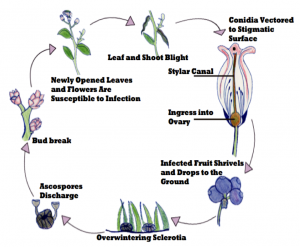From Phil Brannen:
Based on the best information we can derive from the literature at large, cold-damaged, exposed tissue (leaf and early bloom development) is more susceptible to mummy berry blighting, such as we observed in 2013 in many locations (90% losses in some cases). The blighting aspect of the disease basically wipes out whole bloom clusters, and this is not to be confused with the more controlled formation of mummies which occurs much later. Based on current weather predictions, I am hopeful that freezes will be at a minimum over the next few weeks, but we will likely have moisture and temperatures which will be ideal for mummy berry development. Botrytis can also occur on damaged tissue, especially if wet, warming conditions follow.
The bottom line is that the early application of fungicidal materials that have both Botrytis and mummy berry activity are required (i.e. Pristine or DMIs (Orbit, Tilt, Quash, Indar, and generics) + Captan or CaptEvate). Pristine is generally my product of choice for the first application, since it would have activity on mummy berry/Botrytis, and it would have the potential to reduce potential Botrytosphaeria canker infections (also a potential on freeze-damaged stem tissue) as well. However, the advent of putative Exobasidium leaf and fruit spot resistance to Pristine has made me rethink this. If Exobasidium has been observed in your blueberries, I would not utilize Pristine, meaning that DMIs + Captan would be your choice for application during bloom. By label, you can’t mix Pristine with other fungicides or products, so that takes it out of the equation if Exobasidium is a concern.
Harald Scherm has generated current mummy berry information from a model he previously developed and tested. Based on his assessment, assuming that moisture is not limiting in south Georgia, we should be in the advanced stages of apothecium (mummy berry) development and initial infections of exposed green tissue or early bloom tissue as these emerge – especially rabbiteyes. If rain has recently occurred or will be occurring, mummy generation may coincide pretty well with the initial bud germination and push (again, minimally exposed leaf [green tip] or flower tissue can be initially infected).
